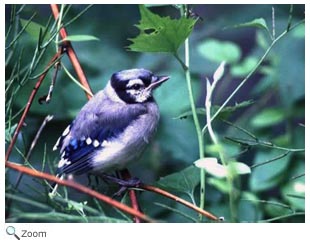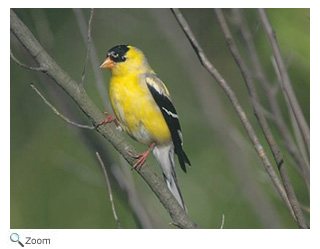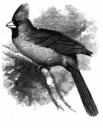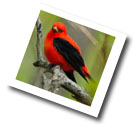Passeriformes - Perching Birds |
|
|
 This is the largest order of birds. In fact, over half of the 10,000 known species of birds in the world are in this order. Passeriformes are also known as perching birds. This is the largest order of birds. In fact, over half of the 10,000 known species of birds in the world are in this order. Passeriformes are also known as perching birds.
Perching birds have three unwebbed toes in the front and one strong, flexible toe in the back called the hallux, that lets them perch on tree branches. Most species of perching birds have 12 tail feathers. Perching birds are found in all parts of the world and they come in a wide variety of colors, patterns, shapes, and sizes! Most chicks in this order are completely featherless and helpless when they hatch and must be fed by their parents.
The order is divided into two suborders - Tyranni and Passeri.
 The Passeri are the songbirds. There are over 4,000 birds in this suborder. They are different from other birds because of the complex set of four muscles in their voice box or syrinx. These muscles allow songbirds to make complex songs and calls. The birds in this suborder can also learn songs! They learn their songs by listening to other birds in their species. The Passeri are the songbirds. There are over 4,000 birds in this suborder. They are different from other birds because of the complex set of four muscles in their voice box or syrinx. These muscles allow songbirds to make complex songs and calls. The birds in this suborder can also learn songs! They learn their songs by listening to other birds in their species.
The Tyranni suborder is made up of over 1,000 species of tropical birds. Most are found in South America. The birds in this suborder also have songs, but they don't learn them. They are born knowing their songs. There are some 64 families in the Passeriformes order.
Families |
 Aegithalidae (long-tailed tits) Aegithalidae (long-tailed tits)
 Aegithinidae (ioras) Aegithinidae (ioras)
 Alaudidae (larks) Alaudidae (larks)
 Artamidae (wood swallows) Artamidae (wood swallows)
 Atrichornithidae (scrub birds) Atrichornithidae (scrub birds)
 Bombycillidae (waxwings ) Bombycillidae (waxwings )
 Calcariidae - (longspurs, snow buntings) Calcariidae - (longspurs, snow buntings)
 Campephagidae (cuckoo shrikes) Campephagidae (cuckoo shrikes)
 Cardinalidae (cardinals, grosbeaks) Cardinalidae (cardinals, grosbeaks)
 Certhiidae (treecreepers) Certhiidae (treecreepers)
 Chloropseidae (leafbirds) Chloropseidae (leafbirds)
 Cinclidae (dippers) Cinclidae (dippers)
 Cinclosomatidae (quail-thrushes) Cinclosomatidae (quail-thrushes)
 Cisticolidae (cisticolas) Cisticolidae (cisticolas)
 Climacteridae (Australian treecreepers) Climacteridae (Australian treecreepers)
 Colluricinclidae (Shrike-thrushes, Pitohuis) Colluricinclidae (Shrike-thrushes, Pitohuis)
 Corcoracidae (apostlebird) Corcoracidae (apostlebird)
 Corvidae (crows, ravens, jays) Corvidae (crows, ravens, jays)
 Cotingidae (cotingas, bellbirds, becards) Cotingidae (cotingas, bellbirds, becards)
 Dicaeidae (flowerpeckers) Dicaeidae (flowerpeckers)
 Dicruridae (drongos) Dicruridae (drongos)
 Emberizidae (old world buntings) Emberizidae (old world buntings)
 Estrildidae (estrildid finches) Estrildidae (estrildid finches)
 Falcunculidae (shrike-tits) Falcunculidae (shrike-tits)
 Fringillidae (true finches) Fringillidae (true finches)
 Hirundinidae (swallows, martins) Hirundinidae (swallows, martins)
 Hypocoliidae (hypocolius) Hypocoliidae (hypocolius)
 Icteridae (orioles, blackbirds) Icteridae (orioles, blackbirds)
 Irenidae (fairy-bluebirds) Irenidae (fairy-bluebirds)
 Laniidae (shrikes) Laniidae (shrikes)
 Maluridae (fairy-wrens, grasswrens) Maluridae (fairy-wrens, grasswrens)
 Melanocharitidae (berrypeckers) Melanocharitidae (berrypeckers)
 Meliphagidae (honeyeaters) Meliphagidae (honeyeaters)
 Menuridae (lyrebirds) Menuridae (lyrebirds)
 Mimidae (mockingbirds, thrashers) Mimidae (mockingbirds, thrashers)
|
 Motacillidae (wagtails, pipits) Motacillidae (wagtails, pipits)
 Muscicapidae (Old World flycatchers) Muscicapidae (Old World flycatchers)
 Nectariniidae (sunbirds) Nectariniidae (sunbirds)
 Neosittidae (sittellas) Neosittidae (sittellas)
 Oriolidae (Old World orioles, figbird) Oriolidae (Old World orioles, figbird)
 Orthonychidae (logrunners) Orthonychidae (logrunners)
 Pachycephalidae (whistlers) Pachycephalidae (whistlers)
 Paradisaeidae (birds of paradise) Paradisaeidae (birds of paradise)
 Pardalotidae (pardalotes) Pardalotidae (pardalotes)
 Paridae (tits, chickadees, titmice) Paridae (tits, chickadees, titmice)
 Parulidae (New World warblers) Parulidae (New World warblers)
 Passeridae (true sparrows) Passeridae (true sparrows)
 Passerellidae - (New World sparrows) Passerellidae - (New World sparrows)
 Petroicidae (Australian robins) Petroicidae (Australian robins)
 Peucedramidae (olive warbler) Peucedramidae (olive warbler)
 Picathartidae (rockfowl) Picathartidae (rockfowl)
 Pipridae (manakins) Pipridae (manakins)
 Polioptilidae (gnatcatchers) Polioptilidae (gnatcatchers)
 Pomatostomidae (babblers) Pomatostomidae (babblers)
 Prunellidae (accentors) Prunellidae (accentors)
 Ptilonorhynchidae (bowerbirds) Ptilonorhynchidae (bowerbirds)
 Pycnonotidae (bulbuls) Pycnonotidae (bulbuls)
 Regulidae (kinglets) Regulidae (kinglets)
 Sittidae (nuthatches) Sittidae (nuthatches)
 Sturnidae (starlings) Sturnidae (starlings)
 Sylviidae (Old World warblers) Sylviidae (Old World warblers)
 Thraupidae (tanagers) Thraupidae (tanagers)
 Timaliidae (babblers) Timaliidae (babblers)
 Troglodytidae (wrens) Troglodytidae (wrens)
 Turdidae (thrushes ) Turdidae (thrushes )
 Tyrannidae (tyrant flycatchers ) Tyrannidae (tyrant flycatchers )
 Vireonidae (vireos) Vireonidae (vireos)
 Zosteropidae (white-eyes
) Zosteropidae (white-eyes
)
|
|
 This is the largest order of birds. In fact, over half of the 10,000 known species of birds in the world are in this order. Passeriformes are also known as perching birds.
This is the largest order of birds. In fact, over half of the 10,000 known species of birds in the world are in this order. Passeriformes are also known as perching birds.



